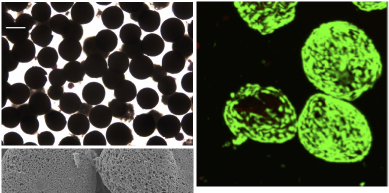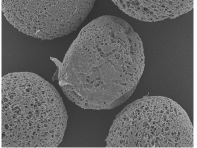 |
||||
|
|
||||
 |
||||
Research - Microcarriers |
||||
Biomaterial microcarriers have been widely utilized to grow cells in suspension and have the potential for the delivery of cell-based therapies. Standard emulsion-based techniques for the production of microcarriers result in particles with a wide range of diameters, leading to potential issues in subsequent cell culture. We are utilizing a more reproducible and homogeneous approach, axisymmetric flow focussing, which uses microfluidics to generate microcarriers with defined size distributions from different blends of biomaterials. |
||
We have grown various cell types, including mesenchymal stem cells, on these microcarriers and have shown they are both cell adhesive and promote high viability in extended culture, offering the potential for cell scale up applications. We have also demonstrated that these cell-laden particles can be used like building blocks in a “bottom-up” approach to generating 3D tissues. When incubated together in a mould, the cells form bridges between the microcarriers to form large, cohesive 3D structures which have the potential to be matured into functional tissues. |
|||||
 |
|||||
 |
Microcarriers made from a blend of gelatin and silk fibroin. Visible light image of as-formed particles (top left; scale bar = 200 μm); fluorescence image of live cells growing on carriers (top right) and scanning electron microscopy image showing the porous nature of the microcarriers (bottom left). |
||||